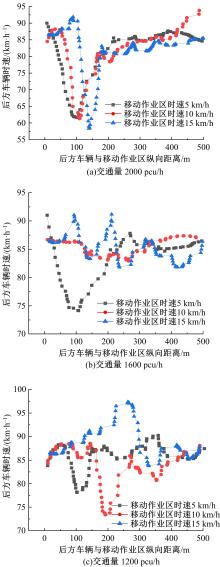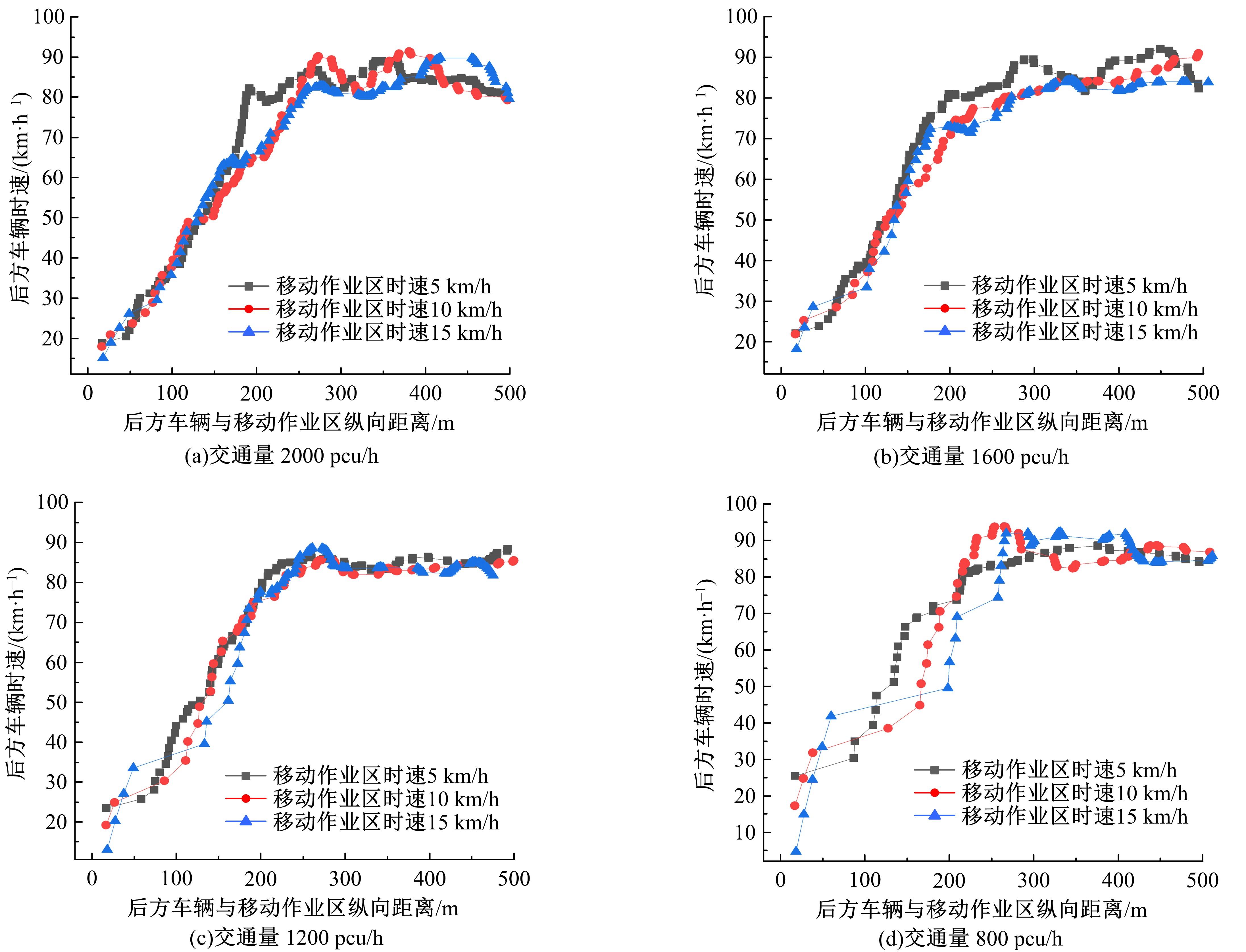吉林大学学报(工学版) ›› 2022, Vol. 52 ›› Issue (8): 1786-1791.doi: 10.13229/j.cnki.jdxbgxb20210154
• 交通运输工程·土木工程 • 上一篇
城市快速路右侧车道移动作业区行车风险分析
- 1.南京林业大学 汽车与交通工程学院,南京 210037
2.南京铁道职业技术学院 机车车辆学院,南京 210031
Traffic risk analysis of moving work zone on right lane of city expressway
Song FANG1,2( ),Jian-xiao MA1(
),Jian-xiao MA1( ),Gen LI1,Ling-hong SHEN1,Chu-bo XU1
),Gen LI1,Ling-hong SHEN1,Chu-bo XU1
- 1.College of Automobile and Traffic Engineering,Nanjing Forestry University,Nanjing 210037,China
2.College of Locomotive and Vehicle,Nanjing Vocational Institute of Railway Technology,Nanjing 210031,China
摘要:
采用VISSIM仿真软件,分析了三车道城市快速路右侧车道移动作业区的影响范围和行车风险变化规律。结果表明:最左侧车道仅在道路交通量达到2000 pcu/h时受到右侧车道移动作业区的间接影响;移动作业区对中间车道的影响受到道路交通量和移动作业区时速的支配;右侧车道后方200 m范围内受到移动作业区的直接影响;当道路交通量达到1600 pcu/h或更低时,随着交通量的降低和移动作业区时速的提高,路段平均行车风险逐渐降低。研究成果可为城市道路作业车辆的运营管理提供科学依据。
中图分类号:
- U491
| 1 | Xu Wen-xiang, Zhao Xiao-hua, Chen Yu-fei, et al. Research on the relationship between dynamic message sign control strategies and driving safety in freeway work zones[J]. Journal of Advanced Transportation, 2018, 2018: 1-19. |
| 2 | Geza P, Robert E B. Work zone impact assessment methods and applications[J]. Transportation Research Record, 2017(2617): 52-59. |
| 3 | Li Ying-feng, Bai Yong. Development of crash-severity-index models for the measurement of work zone risk levels[J]. Accident Analysis and Prevention, 2008, 40(5): 1724-1731. |
| 4 | Meng Qiang, Weng Jin-xian. Evaluation of rear-end crash risk at work zone using work zone traffic data[J]. Accident Analysis and Prevention, 2011, 43(4): 1291-1300. |
| 5 | Mahmoud S, Ikuma L H, Fereydoun A, et al. Effects of work zone configurations and traffic density on performance variables and subjective workload[J]. Accident Analysis and Prevention, 2014, 71: 166-176. |
| 6 | Waleczek H, Geistefeldt J, Middendorf D C, et al. Traffic flow at a freeway work zone with reversible median lane[J]. Transportation Research Procedia, 2016, 15: 257-266. |
| 7 | Du S, Razavi S. Variable speed limit for freeway work zone with capacity drop using discrete-time sliding mode control[J]. Journal of Computing in Civil Engineering, 2019, 33(2): 04019001. |
| 8 | Ge H, Yang Y. Research on calculation of warning zone length of freeway based on micro-simulation model[J]. IEEE Access, 2020(8): 76532-76540. |
| 9 | Wu K, Zhong L. A method for determining length of freeway work zone based on classification of service level[J]. Advanced Materials Research, 2013, 779/780(1): 491-497. |
| 10 | 吴彪,许洪国,戴彤焱,等.高速公路作业区行车风险仿真评价模型[J].交通运输系统工程与信息, 2013, 13(3): 151-156. |
| Wu Biao, Xu Hong-guo, Dai Tong-yan, et al. Simulation evaluation model on driving risk of expressway work zone[J]. Journal of Transportation Systems Engineering and Information Technology, 2013, 13(3): 151-156. | |
| 11 | 彭余华,王晓玉,吕纪娜,等.基于服务水平的高速公路养护作业工作区长度确定方法[J].中国公路学报, 2016, 29(5): 130-136. |
| Peng Yu-hua, Wang Xiao-yu, Ji-na Lyu, et al. Length determination method for expressway maintenance work zone based on service level[J]. China Journal of Highway and Transport, 2016, 29(5):130-136. | |
| 12 | 吴江玲, 张生瑞, Singh A K, 等. 基于交通事故成本控制的高速公路施工区布局优化[J]. 长安大学学报: 自然科学版, 2017, 37(5): 97-103. |
| Wu Jiang-ling, Zhang Sheng-rui, Singh A K, et al. Optimum layout of freeway construction area based on crash cost control [J]. Journal of Chang'an University(Natural Science Edition), 2017, 37(5): 97-103. | |
| 13 | 于仁杰, 马荣国, 韩海, 等. 高速公路施工区限速标志位置确定方法[J]. 交通运输工程学报, 2013, 13(5): 91-98. |
| Yu Ren-jie, Ma Rong-guo, Han Hai, et al. Determination method of speed-limit sign position in expressway work zone[J]. Journal of Traffic and Transportation Engineering, 2013, 13(5): 91-98. | |
| 14 | 周育名, 魏建国, 陈致远, 等. 考虑多因素的高速公路养护区交通组织[J]. 长安大学学报: 自然科学版, 2020, 40(2): 99-108. |
| Zhou Yu-ming, Wei Jian-guo, Chen Zhi-yuan, et al. Traffic organization of expressway maintenance work zone with multi-factors[J]. Journal of Chang'an University(Natural Science Edition), 2020, 40(2): 99-108. | |
| 15 | 孟祥海, 郑来, 毕海峰, 等. 高速公路半幅封闭施工区交通特性与交通冲突特性研究[J]. 中国公路学报, 2013, 26(2): 140-146. |
| Meng Xiang-hai, Zheng Lai, Bi Hai-feng, et al. Research on traffic characteristics and traffic conflicts of one-way closed work zone on expressway[J]. China Journal of Highway and Transport, 2013,26(2): 140-146. | |
| 16 | 郭忠印, 戴忧华, 周小焕. 高速公路隧道(群)风险特征点的临界安全车速及其应用研究[J]. 中国公路学报, 2010, 23(): 116-122. |
| Guo Zhong-yin, Dai You-hua, Zhou Xiao-huan. Critical safety speed and its application research on risk characteristic section of expressway tunnel(tunnel group)[J]. China Journal of Highway and Transport, 2010, 23(Sup.1): 116-122. |
| [1] | 张玮,张树培,罗崇恩,张生,王国林. 智能汽车紧急工况避撞轨迹规划[J]. 吉林大学学报(工学版), 2022, 52(7): 1515-1523. |
| [2] | 郑植,耿波,王福敏,董俊宏,魏思斯. 既有低等级混凝土护栏防护能力提升[J]. 吉林大学学报(工学版), 2022, 52(6): 1362-1374. |
| [3] | 吴文静,战勇斌,杨丽丽,陈润超. 考虑安全间距的合流区可变限速协调控制方法[J]. 吉林大学学报(工学版), 2022, 52(6): 1315-1323. |
| [4] | 徐洪峰,陈虹瑾,张栋,陆千惠,安娜,耿现彩. 面向网联汽车环境的单点全感应式信号配时技术[J]. 吉林大学学报(工学版), 2022, 52(6): 1324-1336. |
| [5] | 盖松雪,曾小清,岳晓园,袁子豪. 基于用户-系统双层优化算法的车位引导模型[J]. 吉林大学学报(工学版), 2022, 52(6): 1344-1352. |
| [6] | 李先通,全威,王华,孙鹏程,安鹏进,满永兴. 基于时空特征深度学习模型的路径行程时间预测[J]. 吉林大学学报(工学版), 2022, 52(3): 557-563. |
| [7] | 冯天军,孙学路,黄家盛,田秀娟,宋现敏. 基于三种过街方式的两相位信号交叉口延误[J]. 吉林大学学报(工学版), 2022, 52(3): 550-556. |
| [8] | 李兴华,冯飞宇,成诚,王洧,唐鹏程. 网约拼车服务选择偏好分析及建模[J]. 吉林大学学报(工学版), 2022, 52(3): 578-584. |
| [9] | 尹超英,邵春福,黄兆国,王晓全,王晟由. 基于梯度提升决策树的多尺度建成环境对小汽车拥有的影响[J]. 吉林大学学报(工学版), 2022, 52(3): 572-577. |
| [10] | 贾洪飞,邵子函,杨丽丽. 终点不确定条件下网约车合乘匹配模型及算法[J]. 吉林大学学报(工学版), 2022, 52(3): 564-571. |
| [11] | 贾彦峰,曲大义,林璐,姚荣涵,马晓龙. 基于运行轨迹的网联混合车流速度协调控制[J]. 吉林大学学报(工学版), 2021, 51(6): 2051-2060. |
| [12] | 薛锋,何传磊,黄倩,罗建. 多式轨道交通网络的耦合协调度[J]. 吉林大学学报(工学版), 2021, 51(6): 2040-2050. |
| [13] | 陆文琦,周天,谷远利,芮一康,冉斌. 基于张量分解理论的车道级交通流数据修复算法[J]. 吉林大学学报(工学版), 2021, 51(5): 1708-1715. |
| [14] | 卢凯,吴蔚,林观荣,田鑫,徐建闽. 基于KNN回归的客运枢纽聚集人数组合预测方法[J]. 吉林大学学报(工学版), 2021, 51(4): 1241-1250. |
| [15] | 何仁,赵晓聪,杨奕彬,王建强. 基于驾驶人风险响应机制的人机共驾模型[J]. 吉林大学学报(工学版), 2021, 51(3): 799-809. |
|
||





